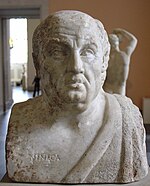Correspondence of Paul and Seneca
| Part of a series on |
| New Testament apocrypha |
|---|
 |
|
|
The Correspondence of (or between) Paul and Seneca,[1]: 6:18 also known as the Letters of Paul and Seneca or Epistle to Seneca the Younger, is a collection of correspondence claiming to be from Paul the Apostle to Seneca the Younger. There are 8 epistles from Seneca, and 6 replies from Paul.[2] Jerome mentioned them in his De Viris Illustribus (chap. 12).[3] However, they are widely held to be forged, as J. B. Lightfoot noted:
- "The poverty of thought and style, the errors in chronology and history, and the whole conception of the relative positions of the Stoic philosopher and the Christian Apostle, betray clearly the hand of a forger."[4]
Philip Schaff in his history said: "They are very poor in thought and style, full of errors of chronology and history, and undoubtedly a forgery."[5] Again, Lightfoot said:
- "This correspondence was probably forged in the fourth century, either to recommend Seneca to Christian readers or to recommend Christianity to students of Seneca."
- "As they are now universally allowed to be spurious, it will be unnecessary to state at length the grounds of their condemnation. It is sufficient to say that the letters are inane and unworthy throughout; that the style of either correspondent is unlike his genuine writings; that the relations between the two, as there represented, are highly improbable; and lastly, that the chronological notices (which however are absent in some important MSS) are wrong in almost every instance. Thus, independently of the unbroken silence of three centuries and a half about this correspondence, internal evidence alone is sufficient to condemn them hopelessly."[6]
According to Bart D. Ehrman, the forged correspondence is most likely an attempt by later Christians to portray Paul as belonging to the intellectual elite of the Roman Empire by having him interact with Seneca, the most influential philosopher of Paul's day and the teacher of emperor Nero. It is designed to address later Christians' bepuzzlement at the 1st-century's most important public figures' apparent ignorance of Jesus' and Paul's existence, let alone their allegedly wonderous deeds. Forging such writings could elevate the prominence of Christianity's founders in history. The correspondence even has Seneca and the Roman emperor abundantly praise Paul as their intellectual superior.[1]: 21:29
References
- ^ a b Bart D. Ehrman (2002). "16: Forgeries in the Name of Paul". Lost Christianities. University of North Carolina at Chapel Hill. Retrieved 20 July 2018.
- ^ Pseudo-Correspondence of St. Paul and Seneca
- ^ De Viris Illustribus - Lucius Annaeus Seneca (WikiSource)
- ^ Lightfoot, Joseph Barber (1892) St Paul and Seneca Dissertations on the Apostolic Age
- ^ Schaff, Philip St. Paul and the Conversion of the Gentiles. History of the Christian Church, Vol.1, Chap.V, Sect.I, Sub.2
- ^ J. B. Lightfoot (1890) The Letters of Paul and Seneca
External links
Template:The Lost Books of the Bible and the Forgotten Books of Eden

